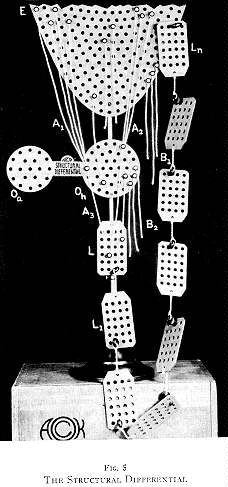





  |




|
|
|
"Whereof one cannot speak, thereof one must be silent."
Ludwig Wittgenstein, Tractatus Logico-Philosophicus, sct. 7 (1922)."The logic of the world is prior to all truth and falsehood."
Ludwig Wittgenstein, Notebooks 1914-1916, entry for October 18, 1914, ed. Anscombe (1961)."By object is meant some element in the complex whole that is defined in abstraction from the whole of which it is a distinction."
John Dewey, On Experience, Nature and Freedom."A hallucination is a fact, not an error; what is erroneous is a judgment based upon it."
Bertrand Russell, repr. In Logic and Knowledge (1956). On the Nature of Acquaintance: Neutral Monism, (1914)."What is 'real'? How do you define 'real'? If you're talking about what you can feel, what you can smell, taste and see, then 'real' is simply electrical signals interpreted by your brain."
Morpheus (Laurence Fishburne), in Wachowski Bothers' "The Matrix" movie."Unfortunately, no one can be told what the Matrix is. You have to see it for yourself."
Morpheus (Laurence Fishburne), in Wachowski Bothers' "The Matrix" movie."It is impossible to step into the same river twice."
Heraclitus, (from Plutarch).
The Structural Differential diagram, created by Korzybski, allows
It thus presents in a visual positive and objective manner, the negative formulations, thus making them usable.

| Typical errors about the Structural Differential |
The SD is perhaps one of the devices that seem to have given a lot of troubles to the general semantics community. Some wanted to improve it, only to run into inconsistencies. The most famous example is "Hayakawa's ladder." This distortion of the SD completely destroys one of its most important features, the relation between the higher order abstractions and the event, that which accounts for consciousness of abstracting. It also reifies the levels of abstracting and does not show the differences between the event and object levels and the following ones as all are represented by one ladder step.
Another model, Bourland's ZEOS shows some misunderstanding of the term "abstracting" and proceeds to 'add' what was already included. It also shows misunderstanding of what the event level is and misrepresents it. Korzybski called the event "the scientific object," i.e. what science talks about.
Finally, many blunders have been made about the 'arrow' that connects the highest abstractions with the event, such as a kind of "bio-feedback" to the lower centres of the brain. The correct answer is in Science and Sanity: science (highest abstractions at a given date) speaks about this event level to which no one has a 'direct' access (since perception occurs at object level). Besides, science is the only way by which we might be conscious of the existence of that level. Thus, Korzybski pegged the highest abstractions to the event level, or drew a long arrow that goes from the highest abstractions to the event level.
Another blunder is to confuse the term "object" with a physical object. In the case of the SD, "object" refers to a construct inside our brains from our perceptions, not to the physical object that could be referred on the SD at the event level. The SD levels beyond and including object level describe something happening inside our heads. Event level can be anything happening, 'inside' and 'outside' having no meaning at this level. This formulation is even better conveyed by Henri Landier's poem. A consequence of that stratification is that a feeling, such as hunger for example, belongs on the SD to the same level as any other observation of events outside our skins. In other words "hunger" is as objective as "blue." There, we see that the SD doesn't treat differently something that happens inside or outside our skins: the SD is a non-elementalistic tool.
Some criticised the SD because it did not mention 'ideas'. Although Korzybski addressed that in another presentation of the SD in his booklet The Role of Language in the Perceptual Processes, there is no necessity to do so. Except for the first and basic event level, all other levels can be considered as multiple without any change in the usefulness of the SD. In other words, it is only useful, for our purpose in general semantics (which is not any kind of neuroscience), to use one object and some small number of labels (usually considering three of the latter is enough, provided we are conscious that the chain of labels can be arbitrarily long).